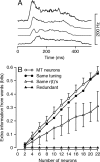The neural basis for combinatorial coding in a cortical population response
- PMID: 19074026
- PMCID: PMC2693376
- DOI: 10.1523/JNEUROSCI.4390-08.2008
The neural basis for combinatorial coding in a cortical population response
Abstract
We have used a combination of theory and experiment to assess how information is represented in a realistic cortical population response, examining how motion direction and timing is encoded in groups of neurons in cortical area MT. Combining data from several single-unit experiments, we constructed model population responses in small time windows and represented the response in each window as a binary vector of 1s or 0s signifying spikes or no spikes from each cell. We found that patterns of spikes and silence across a population of nominally redundant neurons can carry up to twice as much information about visual motion than does population spike count, even when the neurons respond independently to their sensory inputs. This extra information arises by virtue of the broad diversity of firing rate dynamics found in even very similarly tuned groups of MT neurons. Additionally, specific patterns of spiking and silence can carry more information than the sum of their parts (synergy), opening up the possibility for combinatorial coding in cortex. These results also held for populations in which we imposed levels of nonindependence (correlation) comparable to those found in cortical recordings. Our findings suggest that combinatorial codes are advantageous for representing stimulus information on short time scales, even when neurons have no complicated, stimulus-dependent correlation structure.
Figures






References
-
- Abbott LF. Decoding neuronal firing and modeling neural networks. Q Rev Biophys. 1994;27:291–331. - PubMed
-
- Abbott LF, Dayan P. The effect of correlated variability on the accuracy of a population code. Neural Comput. 1999;11:91–101. - PubMed
-
- Aertsen AM, Gerstein GL, Habib MK, Palm G. Dynamics of neuronal firing correlation: modulation of “effective connectivity.”. J Neurophysiol. 1989;61:900–917. - PubMed
-
- Albright TD, Desimone R, Gross CG. Columnar organization of directionally selective cells in visual area MT of the macaque. J Neurophysiol. 1984;51:16–31. - PubMed
Publication types
MeSH terms
Grants and funding
LinkOut - more resources
Full Text Sources
Other Literature Sources
